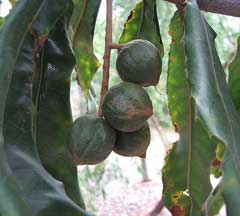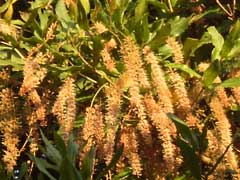 |
|
http://en.wikipedia.org/wiki/User:Melburnian |
 |
|
Translate this page:
Summary
Physical Characteristics

 Macadamia tetraphylla is an evergreen Tree growing to 10 m (32ft) by 10 m (32ft) at a slow rate.
Macadamia tetraphylla is an evergreen Tree growing to 10 m (32ft) by 10 m (32ft) at a slow rate.
See above for USDA hardiness. It is hardy to UK zone 9 and is frost tender. It is in leaf all year. The species is hermaphrodite (has both male and female organs) and is pollinated by Bees. The plant is self-fertile.
Suitable for: light (sandy), medium (loamy) and heavy (clay) soils and prefers well-drained soil. Suitable pH: mildly acid, neutral and basic (mildly alkaline) soils. It cannot grow in the shade. It prefers moist soil.
UK Hardiness Map
US Hardiness Map
Synonyms
Plant Habitats
Woodland Garden Sunny Edge; South Wall. By. West Wall. By.
Edible Uses
Edible Parts: Oil Seed
Edible Uses: Milk Oil
Seed - raw or cooked[2 , 46 , 105 ]. Pleasantly flavoured and nutritious[1 , 61 ], the seed is a little sweeter than the related Macadamia integrifolia and contains a little less oil[301 ]. They can be eaten as a dessert nut and can also be ground into a flour and then mixed with cereal flours to enrich the protein content. The shell is very hard, making it difficult to extract the seed[260 ]. The seed is up to 30mm long and 24mm wide[286 ]. The seed contains up to 72% of a high grade oil[156 , 183 ]. This oil is seldom extracted due to the high value of the seed[63 ].
References More on Edible Uses
Medicinal Uses
Plants For A Future can not take any responsibility for any adverse effects from the use of plants. Always seek advice from a professional before using a plant medicinally.
None known
References More on Medicinal Uses
The Bookshop: Edible Plant Books
Our Latest books on Perennial Plants For Food Forests and Permaculture Gardens in paperback or digital formats.

Edible Tropical Plants
Food Forest Plants for Hotter Conditions: 250+ Plants For Tropical Food Forests & Permaculture Gardens.
More

Edible Temperate Plants
Plants for Your Food Forest: 500 Plants for Temperate Food Forests & Permaculture Gardens.
More

More Books
PFAF have eight books available in paperback and digital formats. Browse the shop for more information.
Shop Now
Other Uses
Cosmetic Fuel Oil Plant breeding Tannin
Agroforestry Uses:
The decomposed husk is commonly used in potting soil[303
].
Other Uses:
Macadamia shells may be used as fuel, generating sufficient energy to dry wet, in-shell nuts[303
].
The oil from the seed is used in cosmetics[307
].
The green seed hulls contain approximately 14% of tannins[303
].
The tree is used as a rootstock for M. Integrifolia[418
].
Special Uses
Food Forest
References More on Other Uses
Cultivation details
Macadamia tetraphylla succeeds in cool tropical or subtropical climates - in Australia they fruit well even when growing at least as far south as Sydney[157
, 335
]. In the tropics the plant fruits best at elevations from 1,000 - 1,500 metres. It grows best in areas where annual daytime temperatures are within the range 14 - 28°c, but can tolerate 8 - 38°c[418
]. When dormant, the plant can survive temperatures down to about -2°c, but young growth can be severely damaged at -1°c[418
]. The plant can survive slight frosts, though cold weather can result in the loss of the entire crop[200
]. It prefers a mean annual rainfall in the range 1,250 - 2,000mm, but tolerates 850 - 3,000mm[418
].
Plants grow best in rich moist but well-drained soils and a position in full sun[117
]. They require copious summer watering in their early stages[167
]. Prefers a pH in the range 5.5 - 7, tolerating 4.5 - 8[418
]. Trees require a sheltered position and are easily damaged by strong winds[117
, 200
].
Plants are slow growing in cultivation, seedlings take 6 - 7 years to produce their first fruit[117
, 167
]. The trees then produce commercial crops for about 40 - 50 years and can fruit for up to 100 years[200
].
There are some named varieties[167
, 183
].
Plants are self-fertile but yield better if cross-pollinated[117
].
Pruning is not normally necessary, but is tolerated if carried out in the autumn[188
].
References Carbon Farming Information and Carbon Sequestration Information
Temperature Converter
Type a value in the Celsius field to convert the value to Fahrenheit:
Fahrenheit:
The PFAF Bookshop
Plants For A Future have a number of books available in paperback and digital form. Book titles include Edible Plants, Edible Perennials, Edible Trees,Edible Shrubs, Woodland Gardening, and Temperate Food Forest Plants. Our new book is Food Forest Plants For Hotter Conditions (Tropical and Sub-Tropical).
Shop Now
Plant Propagation
Seed - best sown as soon as it is ripe in a nursery bed[188
]. The dehusked seed germinates quickly at 25°c[200
].
Cultivars may be grafted. Side wedge grafting has been used exclusively in Hawaii[303
].
Other Names
If available other names are mentioned here
Queensland Nut, Bopple nut, Mukandania,
Native Range
AUSTRALASIA: Australia, New South Wales (northeast), Queensland (southeast),
Weed Potential
Right plant wrong place. We are currently updating this section.
Please note that a plant may be invasive in one area but may not in your area so it's worth checking.
Conservation Status
IUCN Red List of Threatened Plants Status : This taxon has not yet been assessed

Growth: S = slow M = medium F = fast. Soil: L = light (sandy) M = medium H = heavy (clay). pH: A = acid N = neutral B = basic (alkaline). Shade: F = full shade S = semi-shade N = no shade. Moisture: D = dry M = Moist We = wet Wa = water.
Now available:
Food Forest Plants for Mediterranean Conditions
350+ Perennial Plants For Mediterranean and Drier Food Forests and Permaculture Gardens.
[Paperback and eBook]
This is the third in Plants For A Future's series of plant guides for food forests tailored to
specific climate zones. Following volumes on temperate and tropical ecosystems, this book focuses
on species suited to Mediterranean conditions—regions with hot, dry summers and cool, wet winters,
often facing the added challenge of climate change.
Read More
Expert comment
Author
L.A.S.Johnson.
Botanical References
200
Links / References
For a list of references used on this page please go here
A special thanks to Ken Fern for some of the information used on this page.
Readers comment
| Add a comment |
|
If you have important information about this plant that may help other users please add a comment or link below. Only comments or links that are felt to be directly relevant to a plant will be included. If you think a comment/link or information contained on this page is inaccurate or misleading we would welcome your feedback at [email protected]. If you have questions about a plant please use the Forum on this website as we do not have the resources to answer questions ourselves.
* Please note: the comments by website users are not necessarily those held by PFAF and may give misleading or inaccurate information.
To leave a comment please Register or login here All comments need to be approved so will not appear immediately.
|
Subject : Macadamia tetraphylla
|
|
|
|